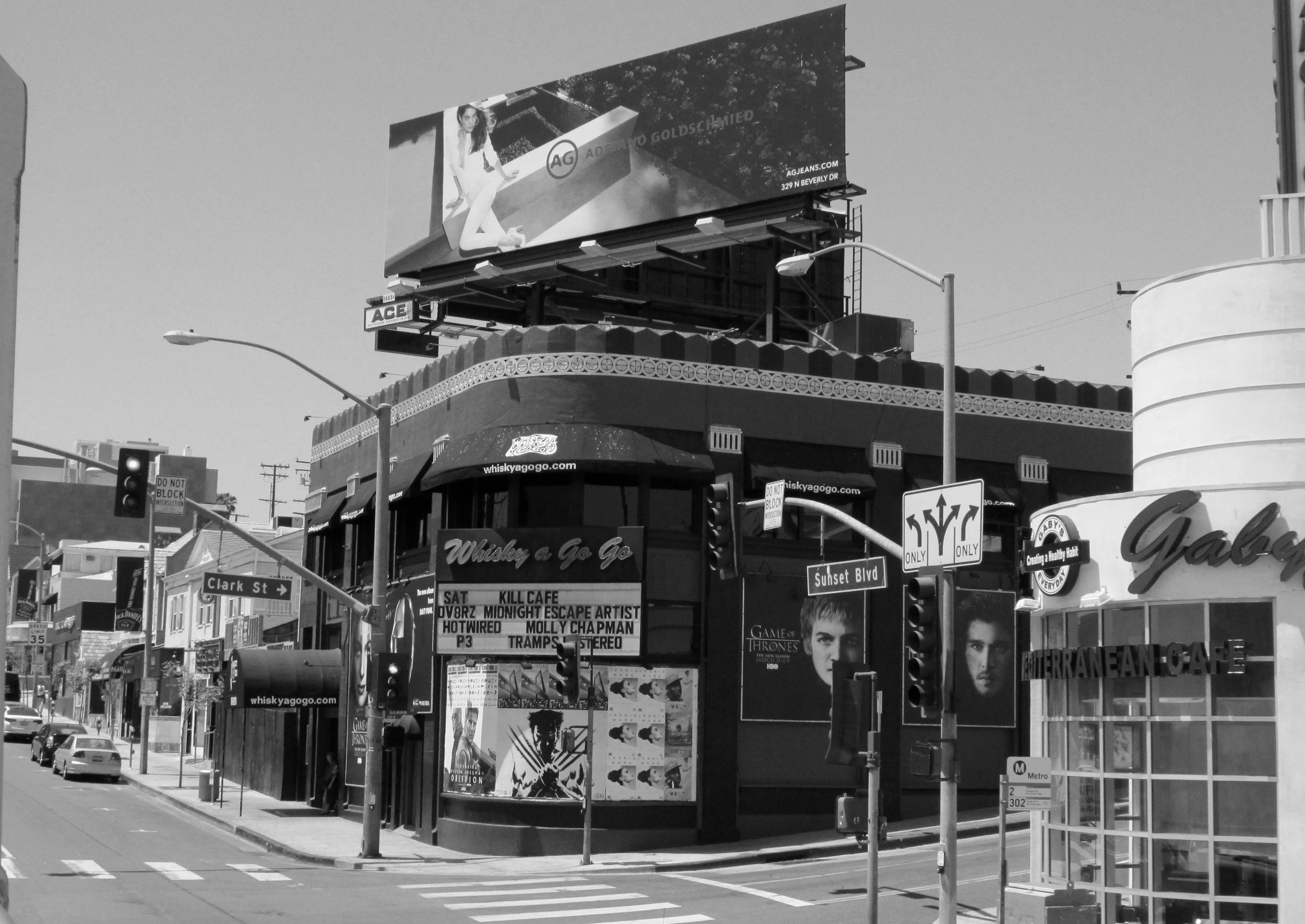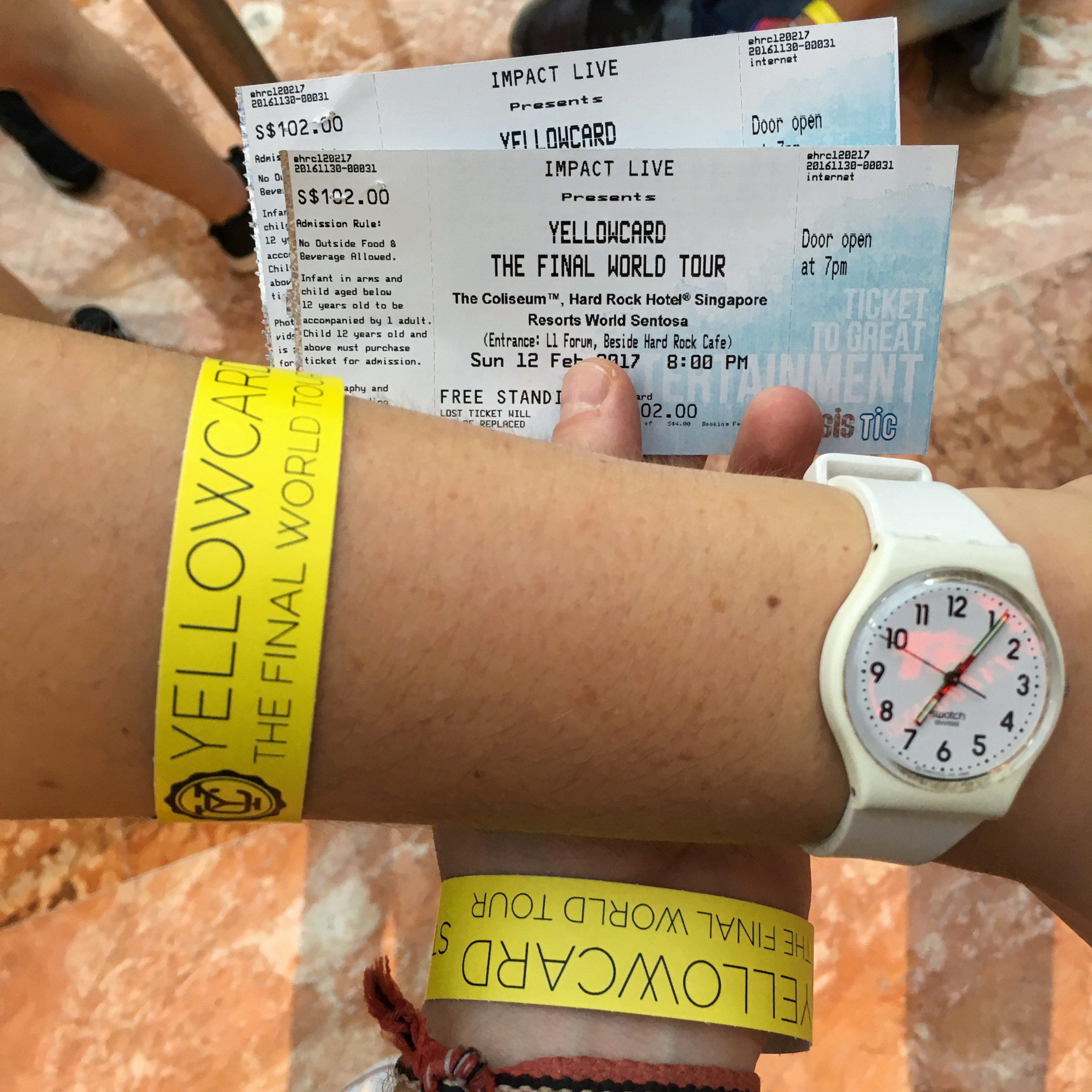"Of Yellow Fruit And Yellowcard" - A Pop-Punk Farewell In Singapore
/Dates of travel: 10 February 2017 to 18 February 2017
Location of travel: Singapore
“It’s quite nice, actually. But I can see why people wouldn’t like it.”
I briefly wince and smack my lips together. I look into the smartphone’s camera to find the right description.
“It’s kinda like fermented custard. This is just the puree; maybe the fresh fruit is a bit more intense". Some dishes just demand a frame rate, as well as a “gotcha” outcome.
How had I ended up at some hawker centre in a spotless, humid South-East Asian country, eating a local fruit that strikes fear into the taste buds (and nostrils) of all who come near to it? Simple: I was here to attend a wake. It just happened to be for a globally renowned pop-punk band.
Rest In Peace
Bands break up in different ways. Some quietly call it quits, and slink off into the night. Some ‘retire’ when they reach old age. Yellowcard - a band I had loved since my early teens - chose to end on a high, releasing one final album and then embarking on a 69-date farewell world tour to 10 different countries.
Ordinarily, this news would register on my music fan radar, I’d feel sad for a while, and then life would move on.
The American group stuck to familiar ports of past success and, as expected, placed most of the tour dates in their home country. I had reason not to get too excited about paying my respects in person.
But being based in the Middle East had its benefits in situations like these: as a global transit hub, almost everywhere is within striking distance.
The Singapore stop on the tour thus presented an interesting opportunity to blend music and tourism. I can’t say that Yellowcard was the only reason my partner and I went, but it definitely was a catalyst for seeking out somewhere warm and in Southeast Asia.
Europe was locked in winter, and with a midweek public holiday needing some annual leave to build around it, the time was ripe to visit the Straits. We got the tickets.
Always Summer
Singapore straddles the Equator, locked in a permanent cycle of light rain and humidity. No matter what day of the year, sunrise and sunset will greet you at roughly the same time.
This harmony extends beyond nature and to society as well. Four voices on the MRT (Mass Rapid Transit) system instruct you at each stop to “please mind the gap” in different tongues. Some areas in the jam-packed city-state, such as Chinatown and Little India, are overtly named after major people groups. It’s a place where cultural diversity is not only encouraged, but is in the very fabric of the country’s history as a former British colonial outpost, and success as a modern-day independent country.
Coming from the desert, we each made sure to invest in a trusty umbrella, packed light for the tropics, and prepared mentally (and physically) for the rare experience of a ‘farewell' show.
In the weeks leading up to our trip, I had Yellowcard’s uptempo tunes on my running playlist, cycling through each album and its emotional highs & lows. At the same time, I read up on the many Singaporean sights to be seen, but very soon discovered a smell that warranted what seemed to be a dubious amount of fuss.
For You, And Your Denial
The infamous durian fruit already warns you with its spiky outer shell (and you thought falling coconuts were dangerous). But you’ll likely know its smell long before one hits you on the head.
The warnings I received from travel websites highlighted not only the nauseating stench (“rotting garbage”, “turpentine”, “stale vomit”) and pervasive flavour, but also the legality of said fruit. Seriously.
In Singapore, the fruit is banned from all forms of public transportation, with its pictogram sitting alongside cigarettes and gas canisters. Even our hotel warned us about bringing this weapon of olfactory destruction into its hallowed suites.
I made it my personal challenge to sample this divisive delicacy, although it seemed unlikely someone would just hand it to you in the street. And even then: how would you pry this pointy food-bomb open? Fortunately, there were hawker centres for this.
These public food palaces are the lifeblood of Singaporean society. Most sit in low-storey parking garage structures and all grade their many food providers by levels of hygiene (A to C, high to low). Hawker centres are a great leveller with great choice; if you have a Chinese-speaking guide and/or friend, the choice could even be narrowed down to vegetarian-only, or be as bold as stingray, eel, and frog's legs.
My initial dalliance with the durian was surface-level at best. When slurped down in a mango chendol (pureed mix of fruits served over shaved ice), the intensity of the fruit was masked - one could say, censored - to suit an easygoing, refreshing dessert. I became complacent.
Convocation
For some travellers, it may be surprising to find out that Singapore is not just one island. The diamond-shaped main island (Pulau Ujong) is the densely packed home to over 5 million people, sitting at the tip of the much larger Malay Archipelago belonging to Malaysia.
Singapore claims a few islets off its coasts, two of the most notable being Pulau Ubin and the resort island of Sentosa, whose southerly location & close proximity echo the mainland's snugness with Malaysia. Within our first day in the Straits, we'd already become acquainted with it, riding the trans-island cable car across Keppel Harbour with South African friends of mine who'd made Singapore their home.
We were treated to stunning 360-degree views of the harbourfront, with brief glimpses above the jungle canopy that envelops the mainland and the numerous skyscrapers that form Downtown. Sentosa was a more nature-friendly respite from the hubbub, but it still had its attractions.
Casinos, theme parks, aquariums, beaches, hotels, and event spaces inside them - like the Hard Rock Colosseum - all vied for one's attention (I even petted a fish). The Colosseum would play host to Yellowcard's swan song to what they presumed would be their Singaporean fans. Plus two rogue South Africans.
You, Me, And One Spotlight
Clad in appropriately yellow event bracelets, we entered the Colosseum the following evening to find that it was actually just a large courtyard, and not a terrifying arena where we'd battle for our lives. There were also no lions (or Merlions - the country's mythical national animal). The stage faced what looked to be terraced suites of the hotel. Their occupants were about to get a blast of violin-coated pop-punk.
Local opening act The Summer State stoked the fires and hearts of the dearly beloved, as they had done for the main drawcard's sole previous visit in 2012. The band oozed positivity and pop, slipstreaming the crowd into the high-strung, high-energy antics of Ryan Key and Co. to come.
And a hero's welcome it was. 'Believe' burst out of the gates; the 9/11 first-responder anthem going straight for the jugular to assure everyone that "everything is gonna be alright/Be strong, believe".
Try telling that to the drummer, Jimmy Brunkvist of the Swedish band Like Torches, who'd been filling in behind the kit since the beginning of this epic final tour. Brunkvist had to learn an imposing 25-song set list, spanning nearly every album Key had fronted since 1999, with all the deep cuts and surprises expected for a send-off.
Sure Thing Falling
But no prizes for guessing what sea-facing street this memory lane wandered down.
The band's magnum opus, 2003's Ocean Avenue, formed the backbone of the show and deservedly drew on six sun-kissed tracks from their breakout record. 'Way Away' surged with swells of sing-alongs and angst, as did 'Breathing' later on in the set. The hits kept battering, and the goodbyes were stayed - for now.
It might seem a strange instrument to have in a pop-punk band, but co-frontman Sean Mackin wielded his violin weapon with giddy rockstar flair and made it an integral part of their sound, as well as performance. You've seen him in some of their music videos doing his string thing, but in the live sphere, he's the band's industrious hype man; whether it's backflipping off of drum risers or simply raising a triumphant fist to the sky.
When attending a wake, you can't ignore the reality in front of you, and Key knew this all too well. There's a time to be earnest, and the lead singer-rhythm guitarist spoke candidly between songs about where they'd come from, and what it had meant playing them for the past two decades. This spiel could've come across as too self-indulgent and maudlin, especially for such a relatively young band on its way out.
But the lengthy intro to 2011's 'Sing For Me' revealed its heartbreaking source: the song was written for Key's aunt Stephanie - a big fan of the band herself - who was diagnosed with brain cancer a year before the album When You're Through Thinking, Say Yes, and has since passed on. I had never known this, and sang for her too.
What Appears
Travel often gets you in a tango with misconceptions about the place you're visiting. It's something to be expected as the bonds of your comfort zone get loosened abroad. However, when the spotlight gets turned back on you, the traveller, it can make for awkward on-the-spot defences of why you chose to visit somewhere for a whole week.
Time and time again, my partner and I received incredulous looks from curious locals close to us (such as taxi drivers, hotel staff, or friends-of-friends) when we were asked where we were going after Singapore. As if it were a mere entree to Southeast Asia, and one was only expected to stay in this glitzy transit hub for no more than the time it takes for a few selfies in front of the Super Trees at Gardens By The Bay?
But apparently that's how it goes down for many visitors to the Straits.
Some come from Europe or the Americas, hoping to make the most of their trip and adding a cheaper leg with stops in Thailand or Bali in neighbouring Indonesia. We ate, saw, and explored more than what could reasonably be fitted into a long weekend and still left with a hypothetical second visit cobbled together in our minds of things to try.
Low-hanging fruit like the futuristic Gardens By The Bay and the boat-shaped Marina Bay Sands hotel obviously wowed with their photogenic views. But being around an extra two or three days gave some breathing room to tackle the tourist trail.
Instead of cramming what could be multiple day-long activities into one, we took our time to look & learn from national galleries & museums, summit the country's highest point in Bukit Timah Nature Reserve (163 metres up!), and test some of the misconceptions we'd arrived with.
Words, Hands, Hearts
My durian quest continued quietly in the background. At each restaurant or hawker stand, my curiosity piqued as I remembered that I still had some strange unfinished business. But then you take a sip of kopi (strong coffee made with condensed milk), nibble a bit of kaya toast (sweet coconut spread), and temporarily forget about this infamous ‘king of fruits’ still waiting to be conquered.
Although there is a concerted effort to promote visibility and harmony among the different people groups of Singapore, I was surprised to find that a significant majority of the population is of Chinese descent (nearly 75%).
Yes, everyone is expected to speak English fluently - even if it mostly takes the form of the local Singlish dialect. But many of its loanwords are Chinese. Signs around town are more likely to have a Chinese translation than the others. A quick scan of faces around you tends to confirm the Sino-social nature of Singapore.
Peranakan women wearing traditional kebaya (blouse) and kasut manik (slippers)
This isn't because of a mass exodus from Beijing or Shanghai (at least currently). They are the 'local' people of Singapore, whose race and heritage reflect the region's predominant immigrants over the years.
The Peranakan - or Straits-born Chinese - are people descended from marriages between either Chinese or Indian men and Malay or Indonesian women from around the Malay Archipelago. Much like the 'Coloured' people of South Africa, the Peranakan are a distinguished blend of cultures who have, in turn, formed their own through generations of living in the Straits.
If you look carefully, you'll find Peranakan cuisine amongst its mainland counterparts (whichever one it may be). Nyonya cooking (old Malay word for 'madame', a term of respect) is usually a fusion of Chinese wok cooking techniques with spices & ingredients for the Malay palate, such as coconut milk, ginger, and tamarind. The result is tangy and spicy; something we were fortunate to experience firsthand at Blue Ginger in Tanjong Pajar.
The Takedown
This tiny Peranakan restaurant sits along a row of quaint shophouses, promising warm authenticity and atmosphere - sorely needed after an outdoorsy afternoon in the Singapore Botanic Gardens, which had seen a prolonged downpour during our visit.
I eyed the dessert menu, noticing two chendol options. One was worded in a particularly patronising tone:
"For those who have not learnt to acquire the taste of the infamous local fruit, the same dessert above can be prepared without the durian puree".
Not on my watch! I requested the 'house favourite' with foolhardy confidence.
The waitress did a double-take and slowly asked if I was sure about this decision. When a different answer wasn't forthcoming, she asked me again - this time with grave concern for my sanity. I know what this is. There were smug smiles all round.
I knew my dish was being served because my partner had leapt from her seat the moment the waitress walked out of the kitchen. The unassuming bowl of pandan leaf jelly, coconut milk, red beans, and some orange-coloured puree radiated the purest, most eye-watering smell I had ever had the misfortune of inhaling. To my uninitiated nose, it was like a fresh baby diaper had been presented on the table for my inspection.
Alone at a table for two, I gagged my way through what was clearly the real deal. 100% durian puree coated the inside of my throat, heralding visions of an imminent return of the contents of my main meal up the route it came in.
I finished half before I admitted defeat. No goodnight kiss tonight.
The Hurt Is Gone
"You may not be aware, but these are the kinds of songs where you have given us the opportunity for so many years now to take the things in our lives that are troubling us - the things we're struggling with - and turn them into songs and music and melodies and lyrics for you guys to listen to."
The lean, tattooed arms of Ryan Key clasped tightly around the microphone. The same boyish face I'd watched on MTV dozens and dozens of times in high school stared into a crowd where I was standing. The floppy undercut hairstyle said 2017, but the nasal vocal inflection was still 'One Year, Six Months' ago, sound-tracking my Senior farewell video.
"And we always hoped that in some small way, we've helped you guys get through your own lives with our music."
The 'good' in goodbye comes from living proof. I saw you. You were real before you left. I had never seen Yellowcard live and in the flesh, so for me it was a twin sensation of solidifying memories for the first time with their source, and knowing that these 'Paper Walls' were coming down, song by song.
Yellowcard's final (self-titled) album is deliberately elegiac, but thank goodness the music holds up regardless. Like The Beatles' Abbey Road and other last rolls of the dice, the band put in their best, knowing it would be the last of their studio output.
Tracks like 'Rest In Peace' and 'What Appears' feel like a natural continuation of the subtle electronics experimented with on 2014's Lift A Sail. 'Got Yours' - a personal favourite of mine, sadly not played on the night - goes toe to toe with something like 'Awakening' from 2012's Southern Air (which was played on the night, and it was massive).
Well, here we go, screaming our lungs out in the encore for 'Only One'. The tears are more real now because I actually tried to get to you. I just had to get a ride on the Sentosa Express, lor.










